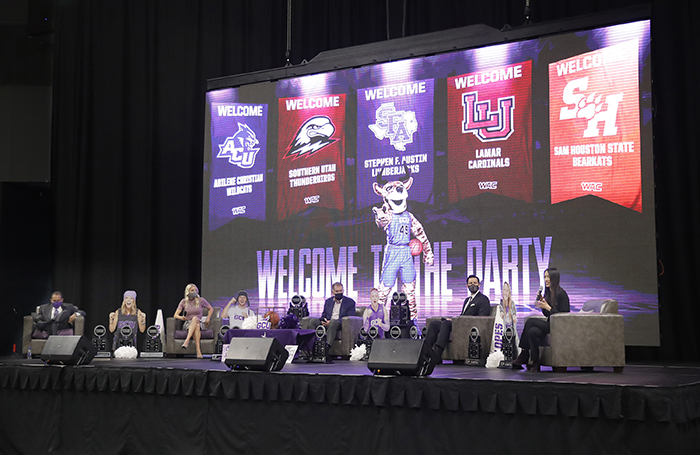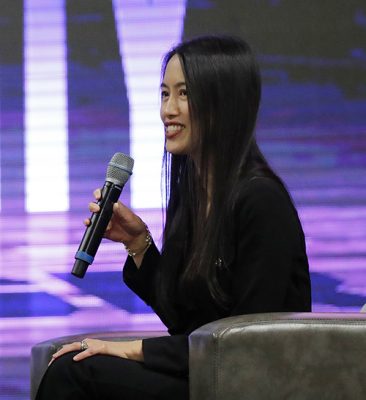
Editor’s note: Reprinted from the February 2021 issue of GCU Magazine. To read the digital version, click here.
By Paul Coro
GCU Magazine
It was an unfathomable scene to envision more than a year ago.
Grand Canyon University’s athletic conference, the Western Athletic Conference (WAC), staged a January event at Houston’s NRG Center, where a red Cardinal and an orange Bearkat roamed a festive foyer with eight university presidents and 10 university athletic directors.
Several media members came to witness a seismic shift in collegiate athletics – a WAC announcement that took moving heaven and earth to welcome five institutions simultaneously.

The presidents of Abilene Christian University, Lamar University, Sam Houston State University, Southern Utah University and Stephen F. Austin University signed certificates in unison. All parties were gone an hour later as if the feat had been simple.
In concept and execution, it was anything but a basic maneuver. It was a move that GCU President Brian Mueller and GCU Interim Vice President of Athletics Jamie Boggs knew was needed. So Mueller, Boggs and Stephen F. Austin administrators initiated the action a year ago, when their talks led that Southland Conference powerhouse in east Texas to start a multi-school move that stabilizes the WAC and positions it to become a top mid-major conference.
“What a phenomenal individual and a visionary with the things Brian is trying to do for Grand Canyon and the WAC,” Stephen F. Austin third year Director of Athletics Ryan Ivey said. “Jamie and I had in-depth conversations about what this is going to look like. Both of us probably thought during some time in there that this wasn’t going to happen.
“There were issues, but determination and perseverance on both our ends was important to get to this point. I’m excited to call them colleagues and conference partners.”
Over GCU’s eight-year WAC membership, Mueller’s roles with the conference helped form an expansion strategy with Boggs and WAC commissioner Jeff Hurd. They initially targeted transitioning Division I programs for a new wave of regional universities that boast growing enrollments, rising population regions and dedication to athletics – like GCU.
California Baptist University joined in 2018. Dixie State University and Tarleton State University became members this year.
That set up the move for like-minded programs of stature, including four former Southland Conference programs that will give the WAC the largest Texas representation (six schools) of any conference in the nation when they join on July 1. Southern Utah will leave the Big Sky Conference for the WAC a year later, just as Chicago State departs the WAC.

Like Stephen F. Austin, Southern Utah fielded overtures for years but never heard a compelling case for such an intensive move until this pandemic interrupted project.
“Grand Canyon is one of the wonderful growth stories in the whole country,” said Southern Utah eighth-year President Scott Wyatt, who has visited GCU often. “Look at what is happening in enrollments in Big Sky schools. Half of them are declining. You’re not seeing that in WAC schools. We’re excited to be in a warmer, Southwest part of the country among growing states and growing universities who have this real vibrant vision.”
The WAC plucked the top four Southland Conference athletic programs to create a 13-team conference featuring warm-weather locales. A two-division format was designed to build or enhance rivalries, regionalize recruiting and reduce travel expenses for many sports. WAC officials envision the conference moving into the top one third of conferences.
“This expansion really raises the profile of all of our sports programs and also increases the level of competition within our conference and increases the exposure for all of our programs,” Boggs said. “It really positions us to be highly competitive at the national level, which is our goal.”
The future composition gives the WAC nine programs from the nation’s two fastest-growing states since 2010 – Texas and Utah. But the new members also align with GCU in dedicating resources to athletics, particularly basketball, for hopes of earning multiple NCAA tournament bids that benefit university profiles and finances.
Mueller gave credit to the authenticity of the university presidents involved and the WAC brethren, who admittedly needed to come together while also plotting how to beat each other.
“It is really hard to get one school to leave a conference,” Mueller said. “You have presidents, athletic directors, coaches, boards, alumni. To get four from Texas and one from Utah at the same time, most people would tell you that’s impossible. There was a lot of persistence. Jamie Boggs had a lot to do with it in terms of rallying the athletic directors, and it happened.”
Now, GCU faces the task of differentiating itself in a restructured WAC – for athletic success and with three new members that also wear purple.
“We always go back to the student-athlete and what’s the best experience for the student-athlete,” GCU women’s basketball head coach Molly Miller said. “We’ve put a premier conference together to give them the best experience.”
****
Related content:
GCULopes.com: GCU Athletics' growth fortified by WAC expansion















